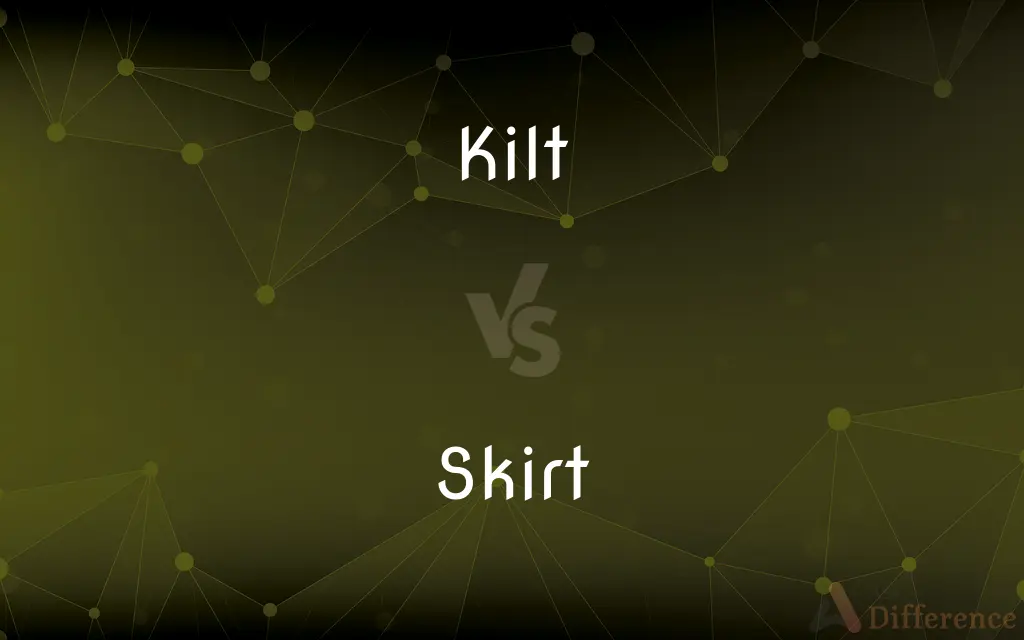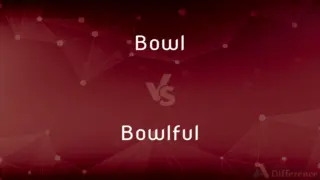Kilt vs. Skirt — What's the Difference?
By Tayyaba Rehman & Maham Liaqat — Updated on March 16, 2024
A kilt is a knee-length garment with pleats at the back, originating from Scotland, while a skirt is a tube- or cone-shaped garment that hangs from the waist or hips.

Difference Between Kilt and Skirt
Table of Contents
ADVERTISEMENT
Key Differences
Kilts are traditionally associated with Scottish culture and are often made of woolen cloth in a tartan pattern. They are designed with pleats at the back and are typically worn by men. Skirts, on the other hand, are a more universal garment worn across various cultures and by all genders. They come in numerous styles, lengths, and materials, making them versatile for different occasions and climates.
While kilts are secured around the waist with straps and buckles, skirts might have a variety of closures, including zippers, buttons, or elastic bands. This difference in closure methods reflects the traditional nature of kilts versus the more modern and varied designs of skirts.
Kilts often serve as a symbol of Scottish heritage and are usually worn on formal occasions or cultural events. Skirts, however, can be worn for both casual and formal settings, depending on their design and the material used, showcasing their adaptability.
The length of kilts is traditionally fixed to knee-length, showcasing a specific style and tradition. In contrast, skirts can vary greatly in length, from mini to floor-length, offering a wide range of options based on personal preference and social norms.
Kilts usually feature tartan patterns, which can indicate the wearer's clan in Scottish tradition. Skirts come in a vast array of patterns, colors, and designs, reflecting a broader spectrum of personal tastes and fashion trends.
ADVERTISEMENT
Comparison Chart
Origin
Scotland
Global
Traditional Wear
Scottish cultural garment
Worn universally across cultures
Material
Usually woolen cloth in tartan pattern
Various materials (cotton, silk, polyester, etc.)
Length
Knee-length
Ranges from mini to floor-length
Gender
Primarily men
All genders
Pleating
Pleats at the back
May have pleats, but not a defining feature
Closure
Straps and buckles
Zippers, buttons, elastic bands
Occasion
Formal events, cultural celebrations
Casual and formal settings
Pattern
Tartan, indicating clan affiliation
Wide range of patterns and colors
Compare with Definitions
Kilt
Traditional Scottish Garment.
The kilt, a traditional Scottish garment, is often worn at Highland games.
Skirt
Universal Garment.
Skirts are a universal garment worn by people of all genders.
Kilt
Symbol of Heritage.
Wearing a kilt is a symbol of Scottish heritage at formal occasions.
Skirt
Colorful and Patterned Designs.
Skirts are available in a wide range of colors and patterns.
Kilt
Made of Woolen Cloth.
Authentic kilts are made of woolen cloth in a tartan pattern.
Skirt
Diverse Lengths.
Skirts come in diverse lengths, from mini to maxi.
Kilt
Secured with Straps and Buckles.
Kilts are secured around the waist with straps and buckles.
Skirt
Flexible in Style.
The style of skirts can range from casual to formal.
Kilt
Knee-Length with Pleats.
A kilt is knee-length and features pleats at the back.
Skirt
Variety of Materials.
Skirts can be made from a variety of materials, including silk and cotton.
Kilt
A kilt (Scottish Gaelic: fèileadh [ˈfeːləɣ]; Irish: féileadh) is a type of knee-length men’s dress skirt non-bifurcated with pleats at the back, originating in the traditional dress of Gaelic men and boys in the Scottish Highlands. It is first recorded in the 16th century as the great kilt, a full-length garment whose upper half could be worn as a cloak.
Skirt
A skirt is the lower part of a dress or a separate outer garment that covers a person from the waist downwards.At its simplest, a skirt can be a draped garment made out of a single piece of fabric (such as pareos). However, most skirts are fitted to the body at the waist or hips and fuller below, with the fullness introduced by means of darts, gores, pleats, or panels.
Kilt
A garment resembling a knee-length skirt of pleated tartan cloth, traditionally worn by men as part of Scottish Highland dress and now also worn by women and girls.
Skirt
The part of a garment, such as a dress or coat, that hangs freely from the waist down.
Kilt
Gather (a garment or material) in vertical pleats.
Skirt
A garment hanging from the waist and worn especially by women and girls.
Kilt
Tuck up one's skirts around one's body.
Skirt
One of the leather flaps hanging from the side of a saddle.
Kilt
A knee-length skirt with deep pleats, usually of a tartan wool, worn as part of the dress for men in the Scottish Highlands.
Skirt
The lower outer section of a rocket vehicle.
Kilt
A similar skirt worn by women, girls, and boys.
Skirt
A flexible strip hanging from the base of an air-cushion vehicle.
Kilt
To tuck up (something) around the body.
Skirt
A piece of fabric that extends over or beyond something to afford protection.
Kilt
To gather up (skirts) around the body.
Skirt
A spray skirt.
Kilt
Nonstandard form of killed.
Skirt
An outer edge; a border or margin
A base camp on the skirt of the mountain.
Kilt
A traditional Scottish garment, usually worn by men, having roughly the same morphology as a wrap-around skirt, with overlapping front aprons and pleated around the sides and back, and usually made of twill-woven worsted wool with a tartan pattern.
Skirt
Offensive Slang A woman.
Kilt
(historical) Any Scottish garment from which the above lies in a direct line of descent, such as the philibeg, or the great kilt or belted plaid
Skirt
To lie along or form the edge of; border
The creek that skirts our property.
Kilt
A plaid, pleated school uniform skirt sometimes structured as a wraparound, sometimes pleated throughout the entire circumference; also worn by boys in the 19th-century United States.
Skirt
To pass around rather than across or through
Changed their course to skirt the storm.
Kilt
A variety of non-bifurcated garments made for men and loosely resembling a Scottish kilt, but most often made from different fabrics and not always with tartan plaid designs.
Skirt
To pass close to; miss narrowly
The bullet skirted an artery.
Kilt
A kind of short petticoat, reaching from the waist to the knees, worn in the Highlands of Scotland by men, and in the Lowlands by young boys; a filibeg.
Skirt
To evade, as by circumlocution
Skirted the controversial issue.
Kilt
To tuck up; to truss up, as the clothes.
Skirt
To lie along, move along, or be an edge or a border.
Kilt
A knee-length pleated tartan skirt worn by men in the Highlands of northern Scotland
Skirt
An article of clothing, usually worn by women and girls, that hangs from the waist and covers the lower part of the body.
Skirt
The part of a dress or robe, etc., that hangs below the waist.
Skirt
A loose edging to any part of a dress.
Skirt
A petticoat.
Skirt
Border; edge; margin; extreme part of anything.
Skirt
The diaphragm, or midriff, in animals
Skirt
To be on or form the border of.
The plain was skirted by rows of trees.
Skirt
To move around or along the border of; to avoid the center of.
Skirt a mountain
Skirt
To cover with a skirt; to surround.
Skirt
To avoid or ignore (something); to manage to avoid (something or a problem); to skate by (something).
He skirted the issue of which parties to attend by staying at home instead.
Skirt
The lower and loose part of a coat, dress, or other like garment; the part below the waist; as, the skirt of a coat, a dress, or a mantle.
Skirt
Border; edge; margin; extreme part of anything
Skirt
A petticoat.
Skirt
The diaphragm, or midriff, in animals.
Skirt
To cover with a skirt; to surround.
Skirted his loins and thighs with downy gold.
Skirt
To border; to form the border or edge of; to run along the edge of; as, the plain was skirted by rows of trees.
Skirt
To be on the border; to live near the border, or extremity.
Savages . . . who skirt along our western frontiers.
Skirt
Cloth covering that forms the part of a garment below the waist
Skirt
A garment hanging from the waist; worn mainly by girls and women
Skirt
Informal terms for a (young) woman
Skirt
Avoid or try to avoid fulfilling, answering, or performing (duties, questions, or issues);
He dodged the issue
She skirted the problem
They tend to evade their responsibilities
He evaded the questions skillfully
Skirt
Pass around or about; move along the border;
The boat skirted the coast
Skirt
Form the edge of
Skirt
Extend on all sides of simultaneously; encircle;
The forest surrounds my property
Common Curiosities
What is a kilt?
A traditional Scottish garment, knee-length with pleats at the back, typically made of woolen cloth in a tartan pattern.
Who wears kilts?
Kilts are primarily worn by men, especially in Scotland, as a symbol of cultural heritage.
Are kilts only made in tartan patterns?
Traditional kilts are often made in tartan patterns, but modern variations might use different fabrics.
How are kilts secured?
Kilts are secured around the waist with straps and buckles.
What materials are skirts made from?
Skirts can be made from a wide range of materials, including cotton, silk, polyester, and more.
What is a skirt?
A tube- or cone-shaped garment that hangs from the waist or hips, worn by all genders across various cultures.
Can skirts have pleats?
Yes, some skirts have pleats, but pleating is not a defining feature as it is with kilts.
Can skirts be worn for formal occasions?
Yes, skirts can be designed for both casual and formal settings, depending on their material and design.
Do kilts have a specific length?
Yes, traditional kilts are knee-length.
Are kilts worn by women?
Traditionally, kilts are worn by men, but modern fashion trends see women wearing kilt-inspired skirts.
How diverse are skirt designs?
Skirt designs are highly diverse, ranging from casual to formal, and varying in length, material, and pattern.
What occasions are kilts worn for?
Kilts are typically worn for formal events and cultural celebrations in Scotland.
Is there a difference in the closure of kilts and skirts?
Yes, kilts typically use straps and buckles, while skirts may use zippers, buttons, or elastic bands.
Can the pattern of a kilt indicate anything?
Yes, in Scottish tradition, the tartan pattern of a kilt can indicate the wearer's clan.
Are skirts a symbol of any particular culture?
Unlike kilts, which are a symbol of Scottish culture, skirts are a universal garment with no specific cultural symbolism.
Share Your Discovery

Previous Comparison
Bowl vs. Bowlful
Next Comparison
Deejay vs. DjAuthor Spotlight
Written by
Tayyaba RehmanTayyaba Rehman is a distinguished writer, currently serving as a primary contributor to askdifference.com. As a researcher in semantics and etymology, Tayyaba's passion for the complexity of languages and their distinctions has found a perfect home on the platform. Tayyaba delves into the intricacies of language, distinguishing between commonly confused words and phrases, thereby providing clarity for readers worldwide.
Co-written by
Maham Liaqat













































